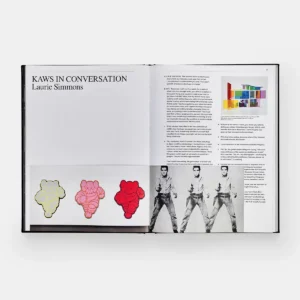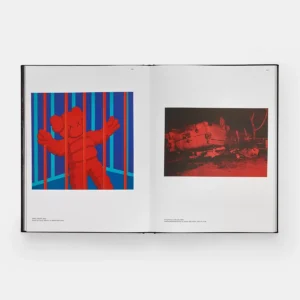KAWS + Warhol by Patrick Moore and Thomas Crow is a groundbreaking artistic dialogue that bridges generations, movements, and mediums. This book offers a compelling visual and intellectual exploration of the parallels between KAWS (Brian Donnelly), a contemporary artist who emerged from street culture and global commercial influence, and Andy Warhol, the undisputed pioneer of Pop Art and one of the most iconic figures in 20th-century art.
In this landmark volume, readers are invited to explore the aesthetic, thematic, and cultural connections between these two giants. Though they come from different times and artistic contexts, both Warhol and KAWS disrupted traditional boundaries in the art world. They each elevated mass media, commercial design, and celebrity culture into powerful tools for artistic commentary—ultimately transforming how art is created, consumed, and understood.
The book opens with a historical overview, setting the stage by outlining Warhol’s rise in the 1960s and his revolutionary use of everyday objects, advertising, and fame. Campbell’s Soup cans, Marilyn Monroe portraits, and Brillo boxes weren’t just images—they were provocations that questioned the value of originality and the role of the artist. Warhol’s studio, The Factory, became a cultural epicenter that blurred the lines between art, fashion, music, and celebrity.
Fast forward to the late 1990s and 2000s, and KAWS emerges from the streets of New York with a background in graffiti and graphic design. His appropriation of pop culture icons—such as Mickey Mouse, SpongeBob, The Simpsons, and Sesame Street characters—resonated with a global audience. Like Warhol, KAWS used repetition, satire, and familiar imagery to build a new visual language that challenged highbrow vs. lowbrow distinctions in contemporary art.
The book expertly analyzes these echoes across generations. Patrick Moore and Thomas Crow, both respected figures in the art world, offer insightful essays that delve into the philosophies, techniques, and impacts of Warhol and KAWS. Through side-by-side comparisons, they reveal how both artists used commercial tools—screen printing, mass production, merchandising—not only to elevate their art but to democratize it. Their work became part of everyday life, reaching audiences far beyond the traditional museum-goer.
A central theme of the book is the idea of authenticity in an age of reproduction. Warhol’s fascination with celebrity personas and media saturation finds a contemporary mirror in KAWS’s exploration of consumer identity, emotional alienation, and the global commodification of childhood nostalgia. The Companion figure, KAWS’s most recognizable character with its crossed-out eyes and slumped posture, reflects a modern emotional tone—both playful and melancholic, familiar yet unsettling. It is the 21st-century cousin to Warhol’s Marilyns—simultaneously iconic and enigmatic.
The visual presentation of KAWS + Warhol is a triumph. The book includes over a hundred high-resolution images that juxtapose key works from both artists. From Warhol’s bold silkscreen prints to KAWS’s monumental sculptures and vinyl toys, the imagery speaks to their shared aesthetic instincts—clean lines, bold color, pop imagery—while emphasizing their distinct emotional textures. These side-by-side visuals invite readers to make connections, draw contrasts, and engage with the artwork in new ways.
Beyond the gallery walls, the book explores each artist’s influence on culture at large. Warhol was a pioneer in branding the artist persona, turning himself into a living artwork. KAWS follows this legacy by creating a global brand identity through collaborations with major companies, from fashion to tech. Both artists understood the power of visibility—how art can transcend the canvas to live in products, advertisements, public installations, and social media.
The essays also touch on their controversial reception within the art world. Warhol was criticized for being superficial and commercial in his time—criticisms that echo today in how some view KAWS. Yet both artists challenged these critiques head-on, using their popularity and mainstream appeal as statements of artistic philosophy. They asked important questions: Who decides what is “serious” art? Can commercial success coexist with artistic integrity? What role does the audience play in defining value?
The book does not attempt to declare one artist greater than the other, nor does it try to force a false equivalence. Instead, it celebrates how both Warhol and KAWS reflect the times they lived in—and how their work resonates across generations. Warhol’s art captured the disorienting rise of celebrity culture and consumerism in post-war America. KAWS, in contrast, gives voice to the digital age’s emotional disconnection, commercial saturation, and nostalgia-driven identity.
Whether you’re a seasoned art historian, a KAWS collector, or a newcomer fascinated by modern visual culture, KAWS + Warhol offers a fresh and thoughtful lens through which to view two of the most recognizable artistic voices of the last century. It is a must-have for those interested in the convergence of art, commerce, and cultural commentary.
More than just a book, KAWS + Warhol is a curated conversation—one that continues long after the final page. It reminds readers that art is never static. It is a living reflection of its time, shaped by those who dare to blur the lines and rewrite the rules.











Reviews
Clear filtersThere are no reviews yet.